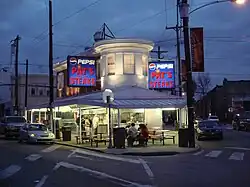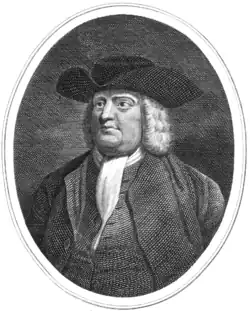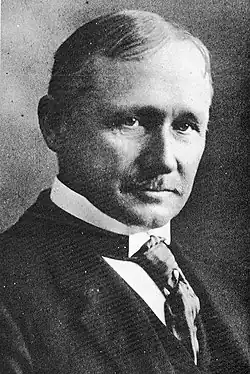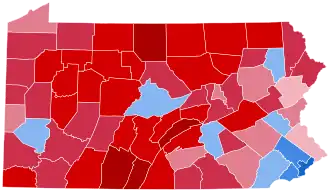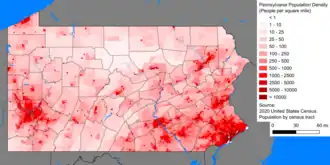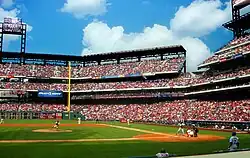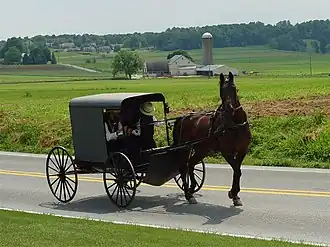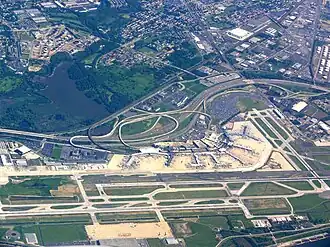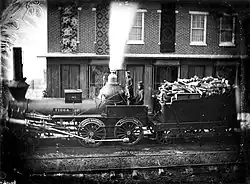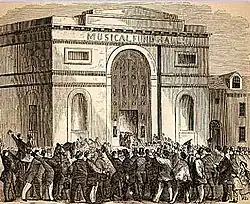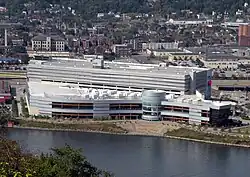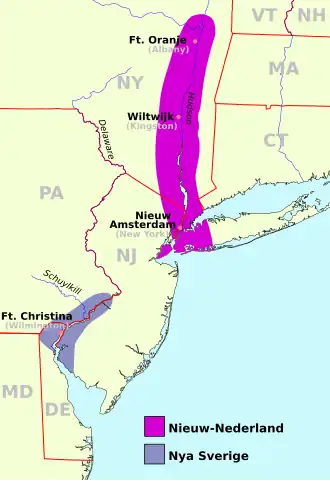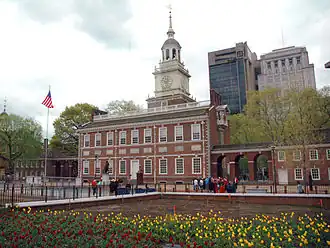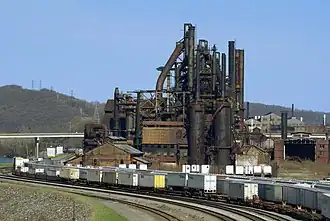The coat of arms of Pennsylvania Pennsylvania Commonwealth of Pennsylvania , is a state spanning the Mid-Atlantic , Northeastern , Appalachian , and Great Lakes regions of the United States . It borders Delaware to its southeast, Maryland to its south, West Virginia to its southwest, Ohio and the Ohio River to its west, Lake Erie and New York to its north, the Delaware River and New Jersey to its east, and the Canadian province of Ontario to its northwest via Lake Erie . Pennsylvania's most populous city is Philadelphia , while the capital of the state is Harrisburg . It is the fifth-most populous U.S. state , with over 13 million residents as of the 2020 United States census , as well as being the ninth-highest by population density and the 33rd-largest state by land area. The largest metropolitan statistical area is the southeastern Delaware Valley , including and surrounding Philadelphia, the state's largest and nation's sixth-most populous city. The second-largest metropolitan area, Greater Pittsburgh , is centered in and around Pittsburgh , the state's second-largest city.
Pennsylvania was founded in 1681 through a royal land grant to William Penn , the son of the state's namesake . Before that, between 1638 and 1655, a southeast portion of the state was part of New Sweden , a Swedish colony. Established as a haven for religious and political tolerance, the colonial-era Province of Pennsylvania was known for its relatively peaceful relations with native tribes, innovative government system , and religious pluralism . Pennsylvania played a vital and historic role in the American Revolution and the ultimately successful quest for independence from the British Empire , hosting the First and Second Continental Congress in Philadelphia , the latter of which formed the Continental Army commanded by George Washington in 1775, during the American Revolutionary War , unanimously adopted the Declaration of Independence the following year. On December 12, 1787, Pennsylvania was the second state to ratify the U.S. Constitution .
The Battle of Gettysburg , fought in July 1863 around Gettysburg , was the deadliest battle of the American Civil War with over 50,000 Union and Confederate fatalities, and resulted in a repulsion of the Confederacy's invasion of the North. Throughout the late 19th and 20th centuries, the state's steel production and manufacturing-based economy contributed to the development of much of the nation's early infrastructure, including key bridges, skyscrapers, and military hardware used in U.S.-led victories in World War I , World War II , and the Cold War . (Full article...
This is a Featured article, which represents some of the best content on English Wikipedia..
Samuel Jackson Randall Pennsylvania who represented the Queen Village , Society Hill , and Northern Liberties neighborhoods of Philadelphia from 1863 to 1890 and served as the 44th speaker of the United States House of Representatives from 1876 to 1881. He was a contender for the Democratic Party nomination for President of the United States in 1880 and 1884 .
Born in Philadelphia to a family active in Whig politics, Randall shifted to the Democratic Party after the Whigs' demise. His rise in politics began in the 1850s with election to the Philadelphia Common Council and then to the Pennsylvania State Senate for the 1st district . Randall served in a Union cavalry unit in the American Civil War before winning a seat in the federal House of Representatives in 1862. He was re-elected every two years thereafter until his death. The representative of an industrial region, Randall became known as a staunch defender of protective tariffs designed to assist domestic producers of manufactured goods. While often siding with Republicans on tariff issues, he differed with them in his resistance to Reconstruction and the growth of federal power. (Full article...
Selected geography article -
Spanish Hill from the south, as depicted in an 1881 lithograph
Spanish Hill borough of South Waverly, Pennsylvania . Opinions regarding the origin of structures found on the site vary from embankments created by early farmers, to the remnants of a Native American village and battlements, due to the site's similarity to the description found in the account of Étienne Brûlé of a settlement called Carantouan. The area in the hill's vicinity was previously occupied by Susquehannock Native Americans. It was a common site for both amateur and professional archaeology, as well as relic hunting. The source of the name remains unknown, but various theories have been proposed as to its origin. (Full article...
Johnstown, Pennsylvania Scranton, Pennsylvania Pittsburgh Philadelphia Bethlehem, Pennsylvania Allentown, Pennsylvania Lancaster, Pennsylvania State College, Pennsylvania Warren, Pennsylvania DuBois, Pennsylvania Erie, Pennsylvania Chambersburg, Pennsylvania Juniata County, Pennsylvania Pithole, Pennsylvania Lock Haven, Pennsylvania Larrys Creek State Route 1002 (Lehigh County, Pennsylvania) Pennsylvania Route 563 Hull Creek (Lackawanna River tributary) Little Fishing Creek Ganoga Lake Mahoning Creek (Susquehanna River tributary) Shawnee on Delaware, Pennsylvania Roaring Brook (Lackawanna River tributary) Pennsylvania Route 463 Kettle Creek (Pennsylvania) West Branch Fishing Creek West Creek (Pennsylvania) Plunketts Creek Bridge No. 3 White Deer Hole Creek Plunketts Creek (Loyalsock Creek tributary) Horseshoe Curve (Pennsylvania) Kinzua Bridge Quehanna Wild Area Harrisburg, Pennsylvania Levittown, Pennsylvania Pennsylvania Turnpike Pocono Mountains Altoona, Pennsylvania
... that 407 species of birds Pennsylvania (Ruffed Grouse , the state bird, pictured) , including four that are extirpated and two that are extinct ?
... that, according to legend, a wooded area in Hellam Township , York County , is home to seven gates that lead directly to hell
... that in the mid-1940s Temple Beth Israel Sharon, Pennsylvania , held Reform services on Friday nights and Orthodox ones on Saturday mornings?
... that General Lee and the Confederate Army retreated over the Sachs Covered Bridge Battle of Gettysburg ?
... that the Inclined Plane Bridge Stonycreek River , connecting the Johnstown Inclined Plane to the city of Johnstown ?
This is a Good article, an article that meets a core set of high editorial standards.
George Washington's crossing of the Delaware River American Revolutionary War , was the first move in a complex and surprise military maneuver organized by George Washington , the commander-in-chief of the Continental Army , which culminated in their attack on Hessian forces garrisoned at Trenton . The Hessians were German mercenaries hired by the British .
Washington and his troops successfully attacked the Hessian forces in the Battle of Trenton on the morning of December 26, 1776. The military campaign was organized in great secrecy by Washington, who led a column of Continental Army troops from today's Bucks County, Pennsylvania across the icy Delaware River to today's Mercer County, New Jersey in what was one of the Revolutionary War's most logistically challenging and dangerous clandestine operations. (Full article...
Selected article -
James Buchanan Jr. bew-KAN -ən ; April 23, 1791 – June 1, 1868) was the 15th president of the United States , serving from 1857 to 1861. He also served as the secretary of state from 1845 to 1849 and represented Pennsylvania in both houses of the U.S. Congress . Buchanan was an advocate for states' rights , particularly regarding slavery , and minimized the role of the federal government preceding the American Civil War .
Buchanan was a lawyer in Pennsylvania and won his first election to the state's House of Representatives as a Federalist . He was elected to the U.S. House of Representatives in 1820 and retained that post for five terms, aligning with Andrew Jackson 's Democratic Party . Buchanan served as Jackson's minister to Russia in 1832. He won the election in 1834 as a U.S. senator from Pennsylvania and continued in that position for 11 years. He was appointed to serve as President James K. Polk 's secretary of state in 1845, and eight years later was named as President Franklin Pierce 's minister to the United Kingdom . (Full article...
Category puzzle Select [►] to view subcategories
Pennsylvania
Pennsylvania-related lists
Communications in Pennsylvania
Demographics of Pennsylvania
Education in Pennsylvania
Environment of Pennsylvania
Geography of Pennsylvania
Government of Pennsylvania
Native Americans in Pennsylvania
Science and technology in Pennsylvania
Tourist attractions in Pennsylvania
Transportation in Pennsylvania
State Facts
Pennsylvania's largest city Philadelphia Nickname: The Keystone State Capital: Harrisburg Largest city: Philadelphia Total area: 119,283 square kilometers (46,055 square miles)Population (2000 census): 12,281,054Date admitted to the Union: December 12, 1787 (2nd )
State symbols
Mountain laurel, Pennsylvania's state flower
The following are images from various Pennsylvania-related articles on Wikipedia.
Image 3 Ethnic origins of Pennsylvanians (from
Pennsylvania )
Image 4 Pittsburgh Steelers ' fans waving the
Terrible Towel , a tradition that dates back to
1975 (from
Pennsylvania )
Image 6 The
Gettysburg campaign , which culminated in the
Battle of Gettysburg , was a major turning point in the
American Civil War and the war's bloodiest battle with an estimated 46,000 to 51,000 casualties (from
History of Pennsylvania )
Image 7 The
colonial possessions of
Britain (in pink),
France (in blue), and
Spain (in orange) as of 1750. The French later lost their possessions in
North America to Britain following its defeat in the
French and Indian War , fought from 1754 to 1763 (from
History of Pennsylvania )
Image 8 Shelter House in
Emmaus , constructed in 1734 by
Pennsylvania German settlers, is the oldest continuously occupied building structure in the
Lehigh Valley and one of the oldest in Pennsylvania (from
Pennsylvania )
Image 9 The
Stonycreek Township crash site of
Flight 93 , one of four planes hijacked in the
September 11 attacks ; the site is now a
national memorial . Flight 93 passengers wrestled with
al-Qaeda terrorist hijackers for control of the plane, preventing it from being flown into the
White House or
U.S. Capitol . (from
Pennsylvania )
Image 10 Simon Cameron of
Maytown was
Secretary of War and head of Pennsylvania's
Republican Party , whose party machine controlled Pennsylvania into the 20th century. (from
History of Pennsylvania )
Image 15 The
Philadelphia Eagles are presented with the
Vince Lombardi Trophy on February 4, 2018, after winning
Super Bowl LII , in which they defeated the
New England Patriots 41–33. (from
Pennsylvania )
Image 16 Pat's King of Steaks in
South Philadelphia is widely credited with inventing the
cheesesteak in 1933. (from
Pennsylvania )
Image 17 Dorney Park & Wildwater Kingdom 's
Steel Force and
Thunderhawk roller coasters in
Allentown ; Steel Force is the eighth-longest
steel roller coaster in the world with a first drop of 205 feet (62 m) and a top speed of 75 miles per hour (121 km/h). Founded in 1884, Dorney Park & Wildwater Kingdom is the fifth-oldest amusement park in the nation. (from
Pennsylvania )
Image 22 The Birth of Pennsylvania , a portrait of
William Penn (standing with document in hand), who founded the
Province of Pennsylvania in 1681 as a refuge for
Quakers after receiving a royal deed to it from
King Charles II (from
History of Pennsylvania )
Image 24 Pennsylvania's unemployment rate between 1976 and 2021
The U.S. unemployment rate during these years
(from
Pennsylvania )
Image 25 Stephen Decatur , a 19th-century
naval commander who served in the
War of 1812 and other engagements (from
History of Pennsylvania )
Image 26 2024 U.S. presidential election results by county in Pennsylvania
Democratic
Republican
(from
Pennsylvania )
Image 27 On November 19, 1863,
President Abraham Lincoln (center, facing camera) traveled to present-day
Gettysburg National Cemetery and delivered the
Gettysburg Address , a 271-word address considered one of the most famous speeches in American history. (from
Pennsylvania )
Image 28 One of only two confirmed photos of
Abraham Lincoln (sitting in center, facing camera, without his traditional top hat) at
Gettysburg a few hours prior to giving the
Gettysburg Address at
Gettysburg National Cemetery on November 19, 1863. The address, which was only 271 words in length, ranks among the most famed speeches in American history. (from
History of Pennsylvania )
Image 29 Pennsylvania population density map (from
Pennsylvania )
Image 30 Citizens Bank Park in
South Philadelphia , home of the
Philadelphia Phillies , the oldest continuous same-name, same-city franchise in American professional sports (from
Pennsylvania )
Image 31 An
Amish family riding in a traditional
Amish buggy in
Lancaster County . As of 2024, Pennsylvania has an Amish population of 92,660, the
largest of any state in the nation. (from
Pennsylvania )
Image 32 Philadelphia International Airport , the busiest airport in the state and the
21st-busiest airport in the nation with over 13 million passengers in 2023 (from
Pennsylvania )
Image 33 The
Köppen climate types of Pennsylvania based on 1991–2020
climate normals (from
Pennsylvania )
Image 34 The locomotive
Tioga in
Philadelphia in 1848; Pennsylvania was an important railroad center throughout the 19th century. (from
History of Pennsylvania )
Image 36 The
Battle of Gettysburg , an 1887 portrait by
Thure de Thulstrup depicting the
Battle of Gettysburg , fought over three days from July 1 to July 3, 1863, in
Gettysburg , which was the
deadliest battle in both the Civil War and all of American military history. The
Union army 's victory at Gettysburg proved the
Civil War's turning point , paving the way for the
Union 's ultimate victory two years later and the nation's preservation. (from
Pennsylvania )
Image 38 A map of
New Netherland (in magenta) and
New Sweden (in blue) in the 17th century; New Sweden was later absorbed by New Netherland and then the
British in the
Second Anglo-Dutch War . (from
History of Pennsylvania )
Image 40 Bethlehem Steel in
Bethlehem was one of the world's leading steel manufacturers for most of the 19th and 20th century. In 1982, however, it discontinued most of its operations, declared bankruptcy in 2001, and was dissolved in 2003. (from
Pennsylvania )
Image 41 The
Statue of Benjamin Franklin on the campus of the
University of Pennsylvania in
West Philadelphia , which pays tribute to
Benjamin Franklin , a
Founding Father who founded the university, now an
Ivy League institution and one of the world's top universities, in 1740 (from
Pennsylvania )
The following Wikimedia Foundation sister projects provide more on this subject:
Discover Wikipedia using portals
List of all portals
Random portal
WikiProject Portals
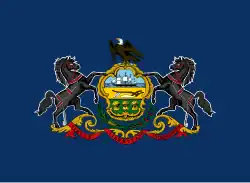
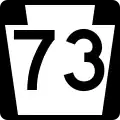
 Good article -
Good article - 
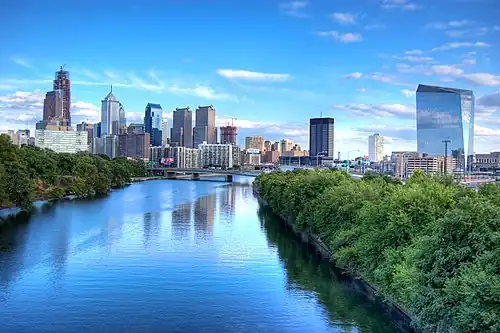

 List of all portals
List of all portals


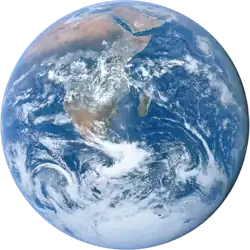





 Random portal
Random portal WikiProject Portals
WikiProject Portals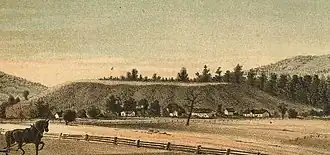


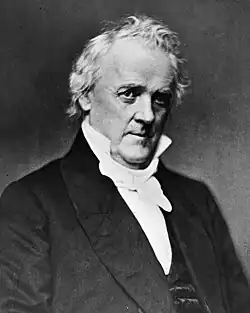
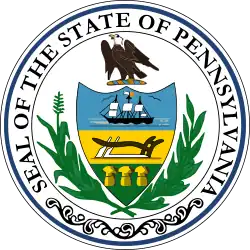
.jpg)
.jpg)
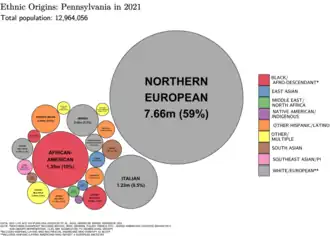

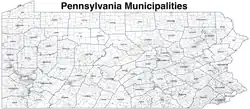
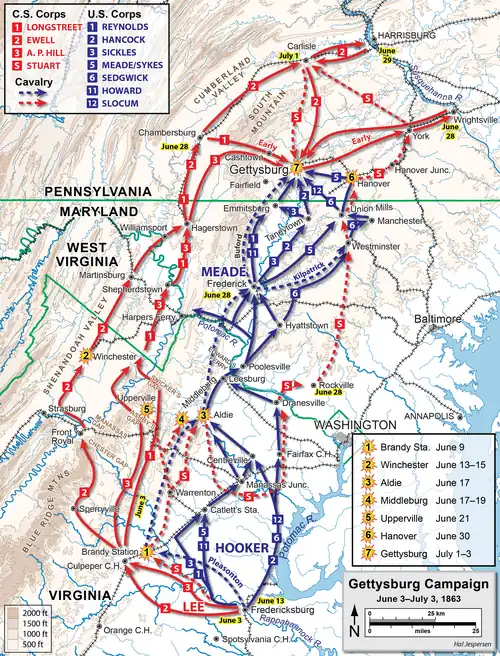
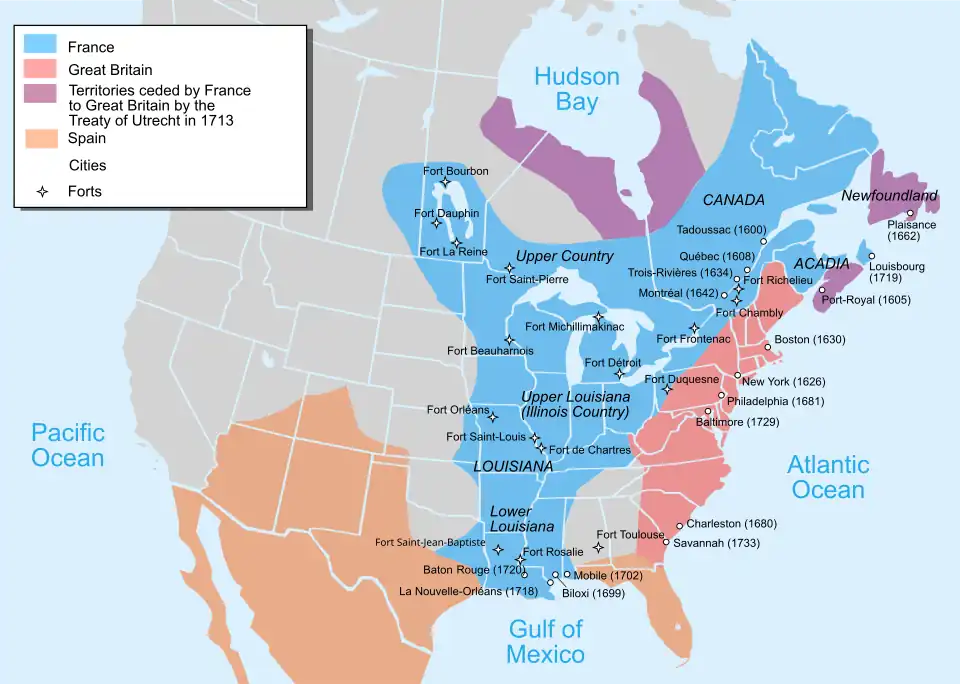
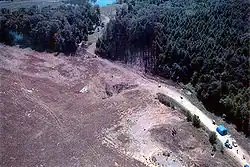
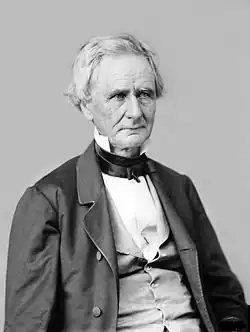
.jpg)
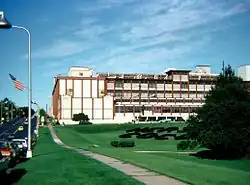
.jpg)

